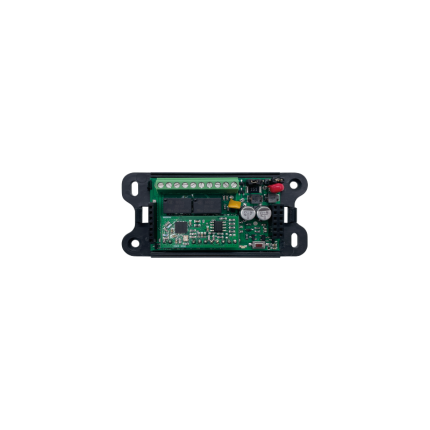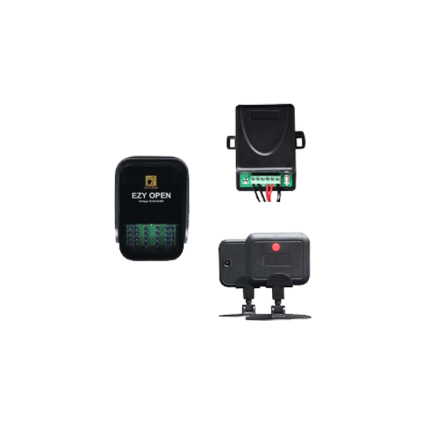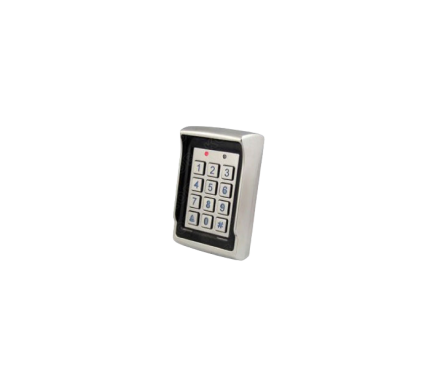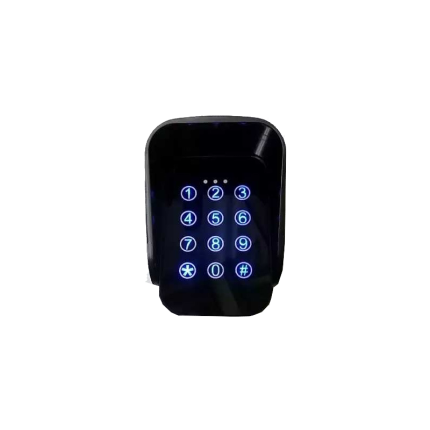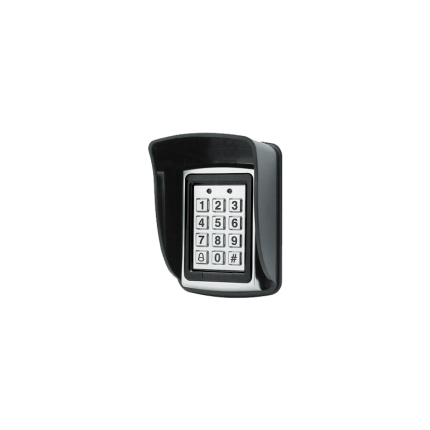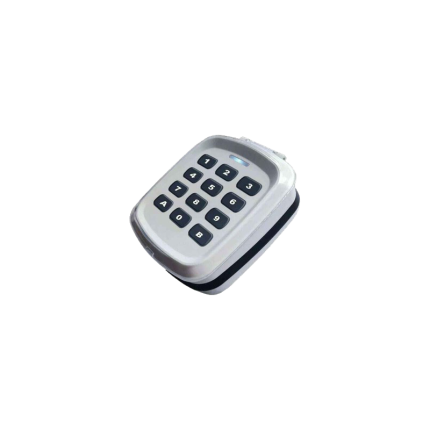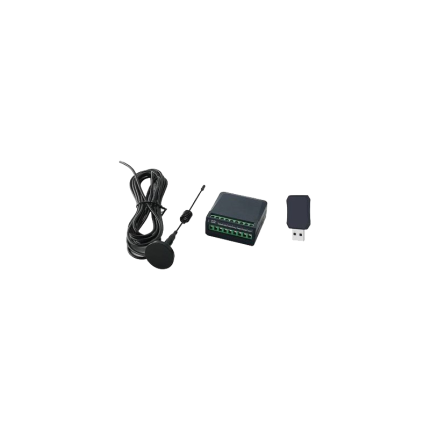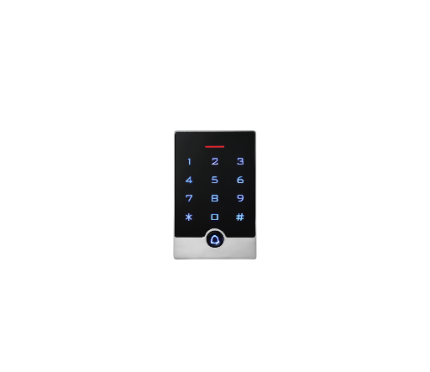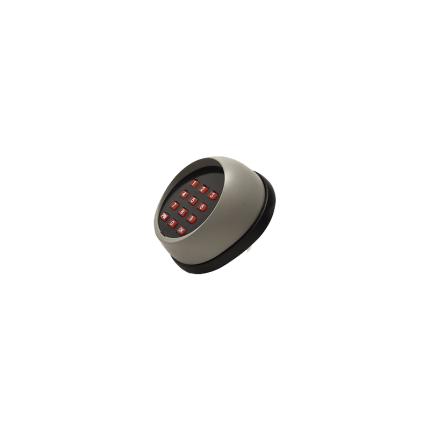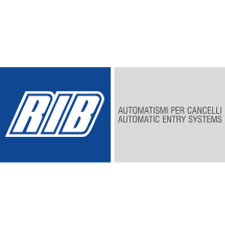Access Control
BUS Encoder -KeyAutomation EGKD2
PRODUCT SHEET PDF
TECHNICAL FEATURES
| Force | N | 93 |
| Duty cycle percentage | % | 100% |
| Voltage | Vac | 10-24 |
| Voltage | Vdc | 12-34 |
| AC Voltage Frequency | Hz | 50/60 |
| Nominal power | W | 0,2 |
| Peak power | W | 23 |
| Appliance isolation class | III | |
| Degree of protection | IP | 30 |
| Dimensions (L - D - H) | mm | 88 - 41 - 25 |
| Item | kg | 0,109 |
| Minimum operating temperature | °C | -10 |
| Max operating temperature | °C | +55 |
Keypad access control K280S6 & Rain Shield Cover
Gate Opener Infrared Remote
An infrared remote for an automatic gate opener allows you to control your gate from a distance, while the infrared sensor provides safety by detecting obstacles and automatically reversing the gate's movement if an obstruction is encountered.
Here's a breakdown:
-
Infrared (IR) Remote:This is a standard remote control, similar to those used for televisions, that transmits a signal to the gate opener using infrared light. You press a button on the remote, and it sends a coded signal to the gate opener's receiver, which then activates the gate motor.
-
Infrared (IR) Sensor:This sensor, often found near the gate, emits an infrared beam. If an object (like a person or car) breaks this beam while the gate is closing, the sensor detects the interruption and signals the gate opener to stop and potentially reverse its direction to prevent accidents.
-
Auto-Open/Close Functionality:Many automatic gate openers also have an "auto-close" feature, allowing you to set a timer for the gate to automatically close after a certain period (e.g., 5, 10, or 20 seconds). This adds convenience by eliminating the need to manually close the gate.
-
Remote Range:The range of the remote control can vary, but typical ranges are around 100 feet (30 meters). Some systems can handle a larger number of remote controls (e.g., up to 25).
-
Safety and Security:The infrared sensor adds a layer of safety to your gate system. The automatic reversing feature helps prevent accidents and property damage.
-
Other Features:Some automatic gate openers also include features like:
- Manual release: Allows you to manually open and close the gate in case of power outages or other emergencies.
- Overheating protection: The motor may have a built-in protection mechanism to prevent overheating.
- Multiple control options: Some systems can also be controlled via a wireless keypad or even through a smartphone app.
- Manual release: Allows you to manually open and close the gate in case of power outages or other emergencies.
Keypad access control K170S300A & Rain Shield Cover
Wireless Keypad Access Control KW200
Wireless keypad access control systems replace traditional keys with a digital PIN code entry for building access, eliminating the need for physical keys and enhancing security.
These systems often include features like remote management via smart devices, audit trails of access events, and integration with other security systems like intercoms.
Here's a more detailed breakdown:
Core Functionality:
-
Keyless Entry:Users enter a unique PIN code into a keypad to unlock a door or gate.
-
Wireless Communication:The keypad communicates wirelessly with a receiver or controller, eliminating the need for extensive wiring.
-
Remote Management:Many systems allow administrators to manage access permissions, view audit trails, and adjust settings remotely via a smartphone app or computer.
-
Integration:Some systems can integrate with intercoms, surveillance cameras, and other security components for a more comprehensive solution.
Key Features:
- PIN Codes: Users are assigned unique PIN codes for entry.
- Proximity Cards/Fobs: Some systems also support access via proximity cards or fobs for users who prefer that method.
- Audit Trails: The system can record and store data about who accessed the door, when, and how, providing a valuable security record.
- Weatherproof and Durable: Many outdoor keypads are designed to withstand harsh weather conditions and vandalism.
- Backlit Keypads: Backlit keypads make it easier to use the system in low-light conditions.
Types of Wireless Keypad Access Control:
- Stand-Alone Systems: These systems are self-contained and don't require connection to a central system.
- Integrated Systems: These systems are part of a larger access control or building management system.
- Wired and Wireless Hybrid: Some systems combine wired and wireless components for added flexibility.
Benefits:
- Enhanced Security: Eliminates the risk of lost or stolen keys.
- Increased Convenience: Users don't need to carry keys.
- Improved Auditability: Tracks access events for security monitoring.
- Remote Management: Allows for easy administration and control.
Wireless Keypad Access Control KW125
Wireless keypad access control systems KW125replace traditional keys with a digital PIN code entry for building access, eliminating the need for physical keys and enhancing security.
These systems often include features like remote management via smart devices, audit trails of access events, and integration with other security systems like intercoms.
Here's a more detailed breakdown:
Core Functionality:
-
Keyless Entry:Users enter a unique PIN code into a keypad to unlock a door or gate.
-
Wireless Communication:The keypad communicates wirelessly with a receiver or controller, eliminating the need for extensive wiring.
-
Remote Management:Many systems allow administrators to manage access permissions, view audit trails, and adjust settings remotely via a smartphone app or computer.
-
Integration:Some systems can integrate with intercoms, surveillance cameras, and other security components for a more comprehensive solution.
Key Features:
- PIN Codes: Users are assigned unique PIN codes for entry.
- Proximity Cards/Fobs: Some systems also support access via proximity cards or fobs for users who prefer that method.
- Audit Trails: The system can record and store data about who accessed the door, when, and how, providing a valuable security record.
- Weatherproof and Durable: Many outdoor keypads are designed to withstand harsh weather conditions and vandalism.
- Backlit Keypads: Backlit keypads make it easier to use the system in low-light conditions.
Types of Wireless Keypad Access Control:
- Stand-Alone Systems: These systems are self-contained and don't require connection to a central system.
- Integrated Systems: These systems are part of a larger access control or building management system.
- Wired and Wireless Hybrid: Some systems combine wired and wireless components for added flexibility.
Benefits:
- Enhanced Security: Eliminates the risk of lost or stolen keys.
- Increased Convenience: Users don't need to carry keys.
- Improved Auditability: Tracks access events for security monitoring.
- Remote Management: Allows for easy administration and control.
Keypad – K180SC103
Key selector -Key Automation EGS101
TECHNICAL FEATURES
| Voltage | Vdc | Max 48 |
| Degree of protection | IP | 55 |
| Dimensions (L - D - H) | mm | 79 - 23 - 79 |
| Item | kg | 0,335 |
| Minimum operating temperature | °C | -20 |
| Max operating temperature | °C | +55 |
A key selector for door openers is a switch that allows you to operate an automated door or gate using a physical key, often as an alternative or backup to other access methods like remote controls or keypads.
These switches are commonly used in situations where you need to control access to a gate, garage door, or other automated barrier.
-
Function:Key selectors are designed to activate the door or gate opener's motor by completing an electrical circuit when the key is turned.
-
Mechanism:They typically involve a key cylinder that, when turned, activates a set of electrical contacts.
-
Applications:They are used in various settings, including residential, commercial, and industrial applications, such as garage doors, gates, and automatic doors.
-
Features:Some key selectors offer multiple functions, like automatic, lock, exit, and hold-open modes.
-
Types:They can be found as jamb key switches for garage doors or as more sophisticated selector switches for automatic doors with multiple functions.

